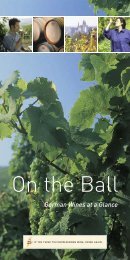the magazine of the german wine institute - Wines of Germany
the magazine of the german wine institute - Wines of Germany
the magazine of the german wine institute - Wines of Germany
You also want an ePaper? Increase the reach of your titles
YUMPU automatically turns print PDFs into web optimized ePapers that Google loves.
34<br />
GERMAN WINE GROWING REGIONS<br />
Mosel<br />
Elegance and class from <strong>the</strong> terrace<br />
NEXT TO THE RHINE, THE MOSEL is certainly one <strong>of</strong><br />
<strong>the</strong> most famous German <strong>wine</strong> rivers. The magnificently<br />
meandering river is called La Moselle<br />
in France and Musel in Luxembourg until it<br />
turns into <strong>the</strong> Mosel at Perl, which flows into <strong>the</strong><br />
Rhine at Koblenz after 250 river kilometres on<br />
German soil. The oldest German <strong>wine</strong>-growing<br />
region – which was already sung about by <strong>the</strong><br />
Roman poet Ausonius – covers a total <strong>of</strong> almost<br />
9,000 hectares <strong>of</strong> vineyards and extends to <strong>the</strong><br />
tributaries Saar and Ruwer.<br />
The wind at <strong>the</strong> Mosel comes mainly from <strong>the</strong><br />
southwest. River and soil both store <strong>the</strong> warmth<br />
during <strong>the</strong> day and release it at night. Because <strong>of</strong><br />
<strong>the</strong> steep rocky slopes along <strong>the</strong> Mosel <strong>the</strong> sun<br />
rays hit <strong>the</strong> ground almost vertically, especially<br />
at <strong>the</strong> Bremmer Calmont, <strong>the</strong> steepest vineyard<br />
in Europe. Animals and plants which need a very<br />
mild climate and which would not be able to live<br />
or grow a few kilometres away in <strong>the</strong> mountains<br />
<strong>of</strong> <strong>the</strong> Eifel or <strong>the</strong> Hunsrück can be found at <strong>the</strong><br />
Mosel: Apollo butterfly, kingfisher and green lizard,<br />
stonecrop and rustyback fern have all made<br />
a home for <strong>the</strong>mselves <strong>the</strong>re.<br />
IT IS KNOWN THAT CELTS SETTLED AT THE MOSEL.<br />
The Romans were particularly significant for <strong>the</strong><br />
region, especially for its viticulture. Around 50<br />
BC, Julius Caesar went to war against Gaul and<br />
travelled through <strong>the</strong> Mosel Valley on his way<br />
<strong>the</strong>re. In 15 BC, <strong>the</strong> Romans founded Augusta<br />
Treverorum, today’s Trier, which even became<br />
<strong>the</strong> seat <strong>of</strong> government <strong>of</strong> <strong>the</strong> Western Roman<br />
Empire in <strong>the</strong> 4th century and grew into <strong>the</strong><br />
largest town north <strong>of</strong> <strong>the</strong> Alps.<br />
At <strong>the</strong> Obermosel between <strong>the</strong> border triangle <strong>of</strong><br />
France, <strong>Germany</strong> and Luxembourg and <strong>the</strong> confluence<br />
<strong>of</strong> <strong>the</strong> Saar at Konz, shell limestone and<br />
keuper are <strong>the</strong> prevailing types <strong>of</strong> soil which provide<br />
a good basis for <strong>the</strong> Pinot varieties and <strong>the</strong><br />
domestic Elbling. From Schweich to Koblenz<br />
slate is <strong>the</strong> main kind <strong>of</strong> soil: here <strong>the</strong> Mosel has<br />
slowly and persistently carved a gorge into <strong>the</strong><br />
Rhenish slate mountains. Many vineyard names<br />
at <strong>the</strong> Mosel end in -lay, indicating <strong>the</strong> fact that<br />
<strong>the</strong> vines are planted on slate: <strong>the</strong> ancient Celtic<br />
term “ley” for slate has survived <strong>the</strong> ages in this<br />
way.



